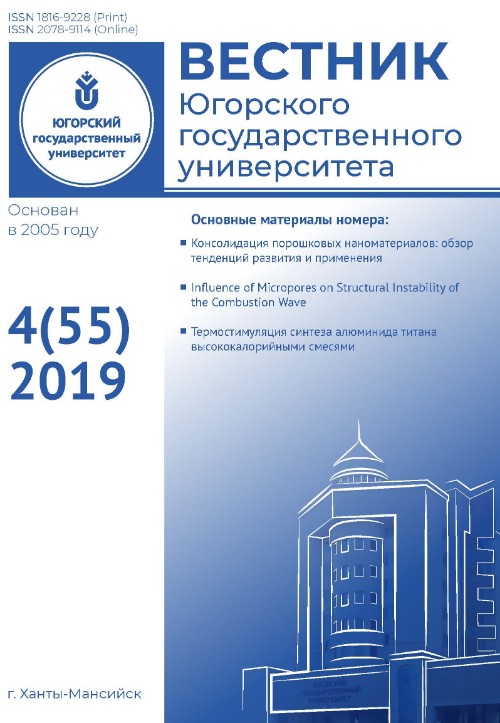Том 15, № 4 (2019)
- Год: 2019
- Выпуск опубликован: 31.12.2019
- Статей: 6
- URL: https://vestnikugrasu.org/byusu/issue/view/1134
НОВЫЕ МАТЕРИАЛЫ И ТЕХНОЛОГИИ
Консолидация порошковых наноматериалов: обзор тенденций развития и применения
Аннотация
В статье представлен краткий обзор литературных данных о методах производства, свойствах и перспективных областях применения консолидированных материалов, полученных из нанопорошков. Рассмотрено влияние размера наночастиц на производительность различных технологий и плотность получаемых продуктов.
 7-16
7-16


Термостимуляция синтеза алюминида титана высококало-рийными смесями
Аннотация
В работе проведен сравнительный микроструктурный и фазовый анализ образцов алюминида титана, полученных метолом СВС в оболочках из высокоэкзотермической термитной смеси и эквимолярной смеси никеля и алюминия. Энергия экзотермических реакций оболочек позволяет разогреть шихту на основе титана и алюминия и запустить в ней СВС-реакцию. В образце спека в оболочке Ni-Al реакция синтеза алюминида титана прошла не полностью; образцы имеют высокопористую структуру с небольшими каркасными включениями интерметаллидов. При синтезе образцов в оболочке из термитной смеси получен сплав, оптимальный по пористости и структуре. Основной фазой в образцах, полученных в разных режимах, является алюминид титана, также в обоих образцах присутствуют включения, обогащенные по титану (фазы Ti3Al, Ti2Al), при этом фазовый анализ не выявил наличие исходных компонентов шихты.
 17-23
17-23


Устойчивые режимы СВС для восстановления молибдена волной горения в системе MoO3 – Al
Аннотация
Работа посвящена технологии восстановления молибдена из окислов методом самораспространяющегося высокотемпературного синтеза в системе MoО3 – AI с добавлением оксида алюминия. Эксперимент проводился в двух режимах: в реакторе при различном давлении без предварительного нагрева и в печи на воздухе до инициирования процесса СВ-синтеза. Получены образцы металлического молибдена в разных режимах синтеза. Рентгенофазовым и рентгеноспектральным анализом установлено, что в синтезированных образцах основной фазой является молибден. Обнаружено присутствие в виде шлака оксидных фаз Al2O3 и МоО2.
 27-32
27-32


Влияние микропористости на структурную нестабильность волны горения
Аннотация
В статье показаны примеры визуализации процесса теплообмена излучением в нестабильных режимах горения пористых порошковых материалов, которые хорошо согласуются с результатами высокоскоростной видеозаписи и микропирометрии. Представлены математическая модель и результаты расчета структуры волны горения в системе Ni-Al. Выявлен вклад радиационного теплообмена при адиабатической температуре горения в диапазоне 8–10 % и эффект его триггерного отключения при понижении температуры.
 33-40
33-40


Стратегические направления противодействия отдельным видам преступлений
Уголовно-правовые и оперативно-разыскные аспекты про-тиводействия преступлениям экстремистской направлен-ности
Аннотация
Автор приходит к выводу, согласно которому антиэкстремистское законодательство не соответствует существующим общественным отношениям, что затрудняет работу по предупреждению экстремистской преступности. Учёный предлагает пересмотреть подходы к криминализации деяний, описанных в ст. 280.1 УК РФ и ст. 282.3 УК РФ, а также отказаться от использованного в ст. 282 УК РФ понятия «социальные группы».
 43-46
43-46


Перспективы уголовной ответственности юридических лиц за преступления в сфере предпринимательской деятель-ности в контексте принципов российского уголовного пра-ва
Аннотация
В научной статье произведён критический разбор аргументов сторонников введения в российское законодательство возможности уголовной ответственности юридических лиц. Автор приводит дополнительные аргументы в пользу того, что введение в отечественное законодательство института уголовной ответственности юридических лиц противоречит принципам российского уголовного права и учению о субъективной стороне преступления. Учёный выступает в пользу необходимости повышения эффективности имеющихся правовых инструментов противодействия общественно опасным деяниям, совершаемым юридическими лицами. Высказано предложение закрепить в законодательстве процедуру принудительной ликвидации юридического лица, выступившего в качестве орудия совершения преступления.
 47-54
47-54











